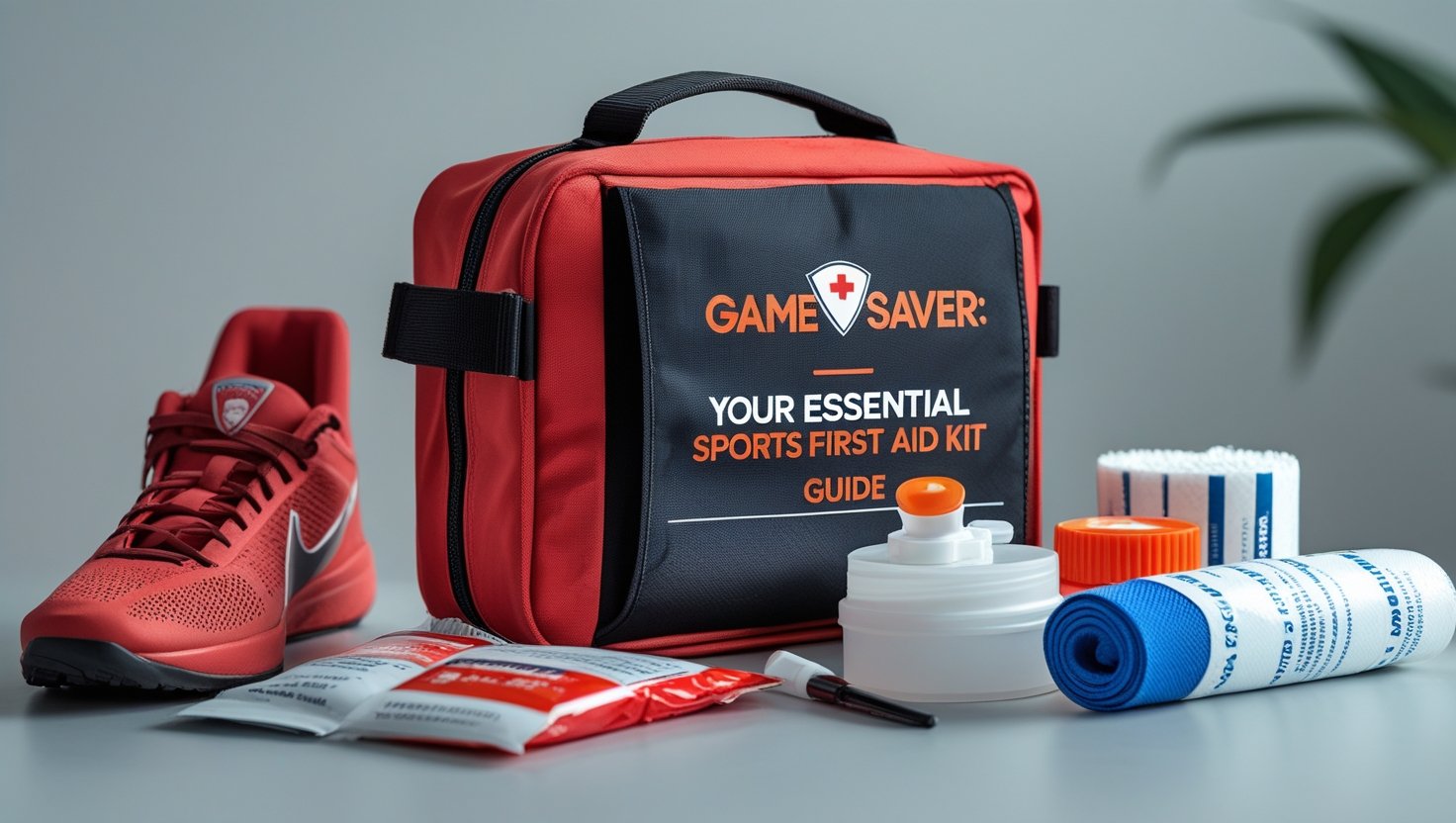Imagine it’s the final quarter. Your star player takes a hard fall scrambling for the ball, and now blood’s streaking down their knee. The clock’s ticking, everyone’s looking at you, Coach. You scramble for your trusty gym bag… only to find spare socks and half-eaten energy bars. Yikes. Could your team handle this moment without chaos?”
This is where a properly stocked Sports First Aid Kit transforms panic into swift, effective care. It’s not just a box of bandaids; it’s your frontline defense against the bumps, bruises, and bigger scares that come with the territory. Think of it like your defensive line for injuries – it stops small problems from becoming season-enders. Let’s get your team protected.
Why Every Team Absolutely Needs a Dedicated Sports First Aid Kit
Look, we’ve all seen that basic plastic box from the drugstore lurking in a closet somewhere. Using a home first aid kit for serious sports action is like bringing a bicycle to a NASCAR race. It might look like it belongs near vehicles, but it’s laughably unprepared for the speed and impact. Sports injuries are different. They demand specific gear for immediate stabilization, managing shock, and handling the unique scrapes and strains athletes face.
Here’s the sobering truth: Safe Kids Worldwide reports a staggering 1.35 million youth sports ER visits yearly. Being prepared isn’t just smart coaching; it’s non-negotiable. Think about:
- Legal & Liability: Coaches and organizations have a duty of care. A stocked, accessible kit is fundamental to meeting that standard. Imagine explaining why you didn’t have an instant cold pack for that swollen ankle.
- Psychological Comfort: Players perform better knowing help is ready. Parents sleep easier. It builds trust – in you, and in the team environment.
- Game Flow: Quick, effective first aid gets minor issues handled fast, minimizing delays and getting athletes back in action safely when possible. No one wants a 20-minute hunt for a gauze pad!
The Non-Negotiables: Your Core Sports First Aid Kit Checklist
Forget guesswork. Your core kit needs these MVP items, ready for anything from turf burn to a potential sprain. Think of this as your starting lineup:
| Item Category | Specific Items | Why It’s Crucial for Sports |
|---|---|---|
| Wound Care | Sterile gauze pads (various sizes), Fabric adhesive bandages (assorted), Blister-specific pads (hydrocolloid), Antiseptic wipes | Handles abrasions, cuts, deep scrapes, and dreaded turf burns instantly. Fabric bandages stay put during sweat. |
| Injury Management | Elastic wrap bandages (3″ & 4″), Triangular bandage (sling/immobilization), Instant cold packs, Athletic tape (pre-wrap & rigid), Finger splints | Stabilizes sprains, strains, potential fractures IMMEDIATELY. Controls swelling fast. |
| Tools & PPE | EMT shears (cuts tape/clothing), Tweezers (splinters!), Disposable nitrile gloves (multiple pairs), CPR face shield | Safety FIRST for both responder and athlete. Essential for accessing injuries. |
| Medications | Antibiotic ointment packets, Hydrocortisone cream (rashes/insect bites), Ibuprofen/Acetaminophen packets (Coach/admin ONLY per strict policy!) | Fights infection, calms skin reactions. Pain relief must follow organizational protocols and NEVER be given to minors without explicit parental consent. |
Pro Tip: Buy quality brands built for athletics – think Cramer or Mueller for wraps and tape. They hold up under sweat and stress.
Level Up Your Kit: Sport-Specific Savvy Adds
Your core kit is solid, but just like playbooks, customization wins games. Tweak it for your sport:
- Football/Rugby (High Contact): Consider trainer-style cervical collars (for trained personnel only!), heavier-duty wraps (like 6″ elastic), mouthguard remover tool, extra cold packs. Contact demands robust gear.
- Soccer/Track (Feet & Ankles): DOUBLE DOWN on blister care! Moleskin sheets, donut pads, extra hydrocolloid bandages. Add a couple of quality ankle braces for quick stabilization. Those cleats and miles add up.
- Basketball/Volleyball (Jumps & Hands): “Buddy tape” for taped fingers, jumbo knee/elbow pads for abrasions, extra finger splints. Jammed fingers and floor burns are practically part of the game.
- Outdoor Sports (Baseball, XC, etc.): Insect sting relief wipes, emergency foil blanket (shock/hypothermia), extra water packets/small bottle, maybe even a whistle. Weather and bugs add another layer.
Beyond the Bandages: Smart Kit Management & Training
Listen up, because this is where many kits fail: A sports first aid kit is utterly useless if no one knows where it is or how to use it. Period.
- Storage: Get a durable, clearly marked bag (bright colors!). Use clear pouches or compartments inside so you can SEE what’s missing instantly. Weather-resistant is key for outdoor sports – keep it off wet ground!
- Training is Mandatory: That EMT shear? The triangular bandage? They’re not self-explanatory. Crucially: Link your kit to basic First Aid and CPR training. Every coach, and ideally a team manager or two, must have this. Check Red Cross, ASHI, or local provider courses – it’s an investment that saves lives. Run quick drills: “Show me how you’d apply a cold pack and wrap for a sprained ankle.”
- Proof it Works: Take Jefferson High. After they started doing monthly kit checks and 10-minute “wound care” drills with staff, their game delay times for injuries dropped by 70%. Faster care, less disruption. Win-win.
Common Kit Pitfalls (And How to Dodge Them)
Don’t let these rookie mistakes bench your safety game:
- Myth: “Expired supplies are better than nothing?” Nope! That ointment loses potency. That wrap gets brittle. Ineffective and potentially risky. Bin it!
- Forgetting the Restock: Used your last cold pack? Write it down ON THE KIT BAG and replace it before the next practice. No excuses.
- The Hidden Kit: If it’s locked in the office or only the head coach knows the “secret spot,” it fails. It needs to be courtside/fieldside, visible, and accessible to multiple trained staff instantly. A bright bag on the bench is perfect.
- Ignoring Sport/Season: Your summer soccer kit needs different stuff (sting relief!) than winter basketball (maybe that foil blanket for cold gyms). Rotate items as seasons/sports change.
Build Your Shield – Game On!
Putting together your ultimate Sports First Aid Kit isn’t just ticking boxes on a list. It’s building a tangible shield for your team’s health, safety, and peace of mind. It’s saying, “We’re ready for you, game.” So, your next plays?
- Audit your current kit THIS WEEK. Get ruthless – bin anything expired, damaged, or missing.
- Add at least 3 sport-specific items from our list above. Target your biggest pain points (blisters? ankles?).
- Schedule a 15-minute demo next practice. Show the team (and staff!) where the kit lives and how to use the cold pack and a basic wrap. Familiarity breeds confidence.
What’s the FIRST item you’ll be adding or replacing? Share your game plan below – let’s learn from each other!
FAQs:
Q: How often should I check and restock our sports first aid kit?
A: Do a quick visual scan before EVERY practice and game (gloves there? cold packs intact?). Do a full inventory, checking expiration dates, every 3 months. And crucially, restock IMMEDIATELY after anything is used!
Q: Can I just grab a standard first aid kit from the drugstore?
A: It’s a start, sure – better than nothing in a pinch. But seriously? Standard kits skimp on the heavy-duty sports needs: enough elastic wraps, multiple instant cold packs, proper blister care, and often the sheer volume needed for a team. They’re built for kitchen cuts, not sideline emergencies.
Q: Who’s responsible for the team’s kit?
*A: Ultimately, the coach and organization own it. But designate 1-2 reliable people (team manager, assistant coach, trainer) for daily checks and ensuring it’s courtside. Crucially, EVERY staff member must know its location and how to access it fast.*
Q: Can coaches give athletes meds (like ibuprofen) from the kit?
A: ABSOLUTELY NOT without explicit, written parental/guardian consent AND strict adherence to your organization’s policy. Best practice? Only administer medication provided directly by the parent for their specific child. When in doubt, skip it and call the parent.
Q: What’s the most overlooked item?
A: Blister care, hands down! Friction burns and blisters sideline players constantly, especially in cleats or running shoes. Moleskin and hydrocolloid pads are absolute game-changers for keeping athletes on the field.
Q: Should kits differ for youth vs. adult teams?
A: The core essentials are similar. But make sure bandage sizes are appropriate for smaller limbs. Sometimes kid-friendly bandage designs help ease fear. BIGGEST DIFFERENCE? Medication protocols are infinitely stricter for minors. When in doubt, wait for parents.
Q: Where’s the best spot for the kit during action?
A: Courtside. Fieldside. On the bench. In a bright, obvious bag. ALWAYS within immediate reach during practice or games. Never locked away, never in a distant office. Seconds count.
READ ALSO: Beyond the Bottle: Why Your Supplement Brand’s Secret Weapon Might Be a Custom Gummy Manufacturer

